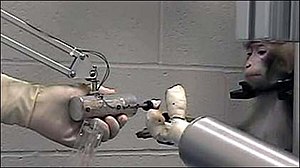Feeling Robotic Arms Improves Brain Machine Interfaces | Neuroscience News
 Image via WikipediaFeeling Robotic Arms Improves Brain Machine Interfaces | Neuroscience News
Image via WikipediaFeeling Robotic Arms Improves Brain Machine Interfaces | Neuroscience NewsProprioception feedback of a robotic arm helped improve the performance ofmonkeys using brainmachine interfaces to control a computer cursor. When the monkeys were fit with exoskeletons that provided arm movements synchronized with the cursor movement, control of the cursor improved by 40%.
These findings could lead to better brain machine interfaces for some suffering from spinal cord injuries.
Robot arm improves performance of brain-controlled device
Adding sensory feedback could help spinal cord injury patients operate computers, robots
The performance of a brain-machine interface designed to help paralyzed subjects move objects with their thoughts is improved with the addition of a robotic arm providing sensory feedback, a new study from the University of Chicago finds.
Devices that translate brain activity into the movement of a computer cursor or an external robotic arm have already proven successful in humans. But in these early systems, vision was the only tool a subject could use to help control the motion.


No comments:
Post a Comment